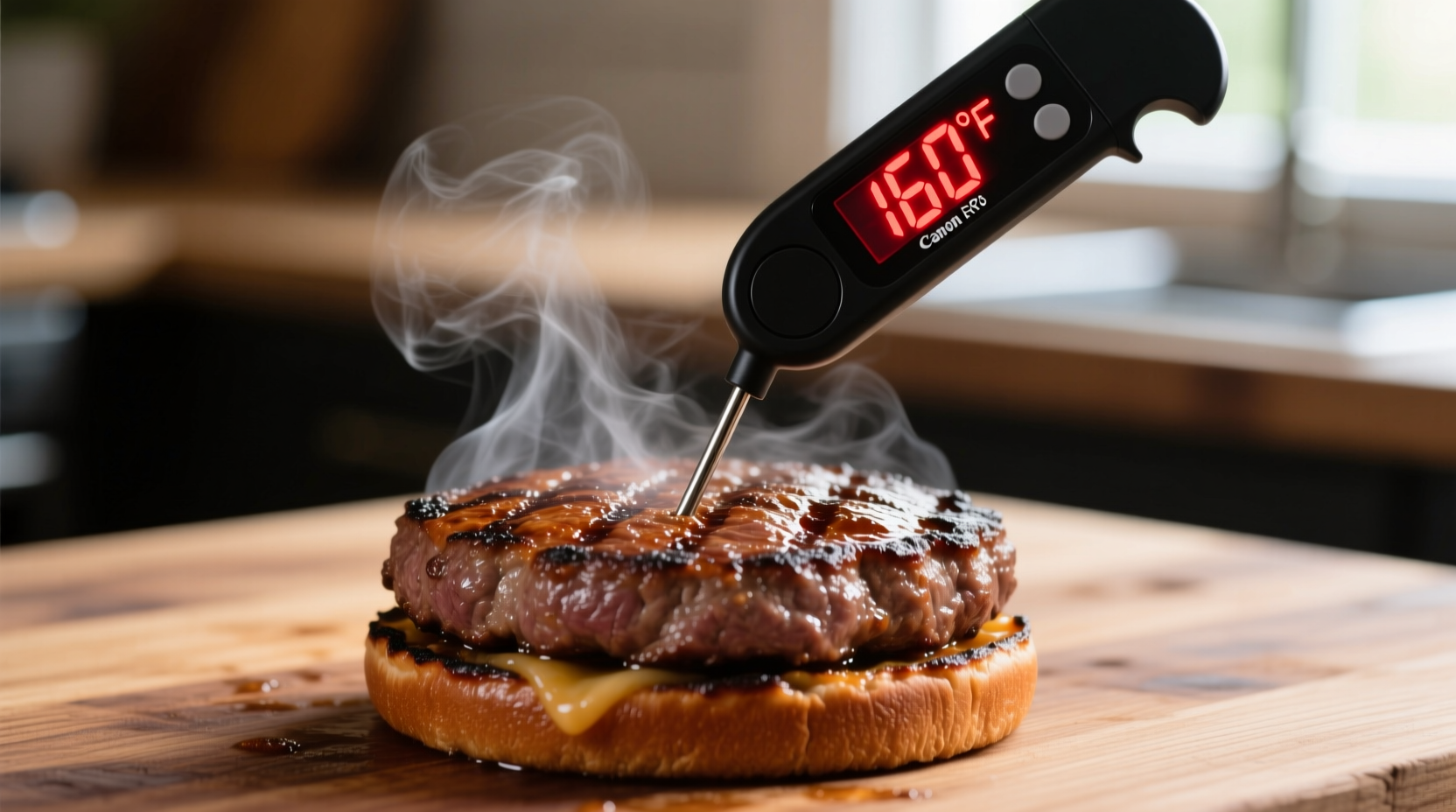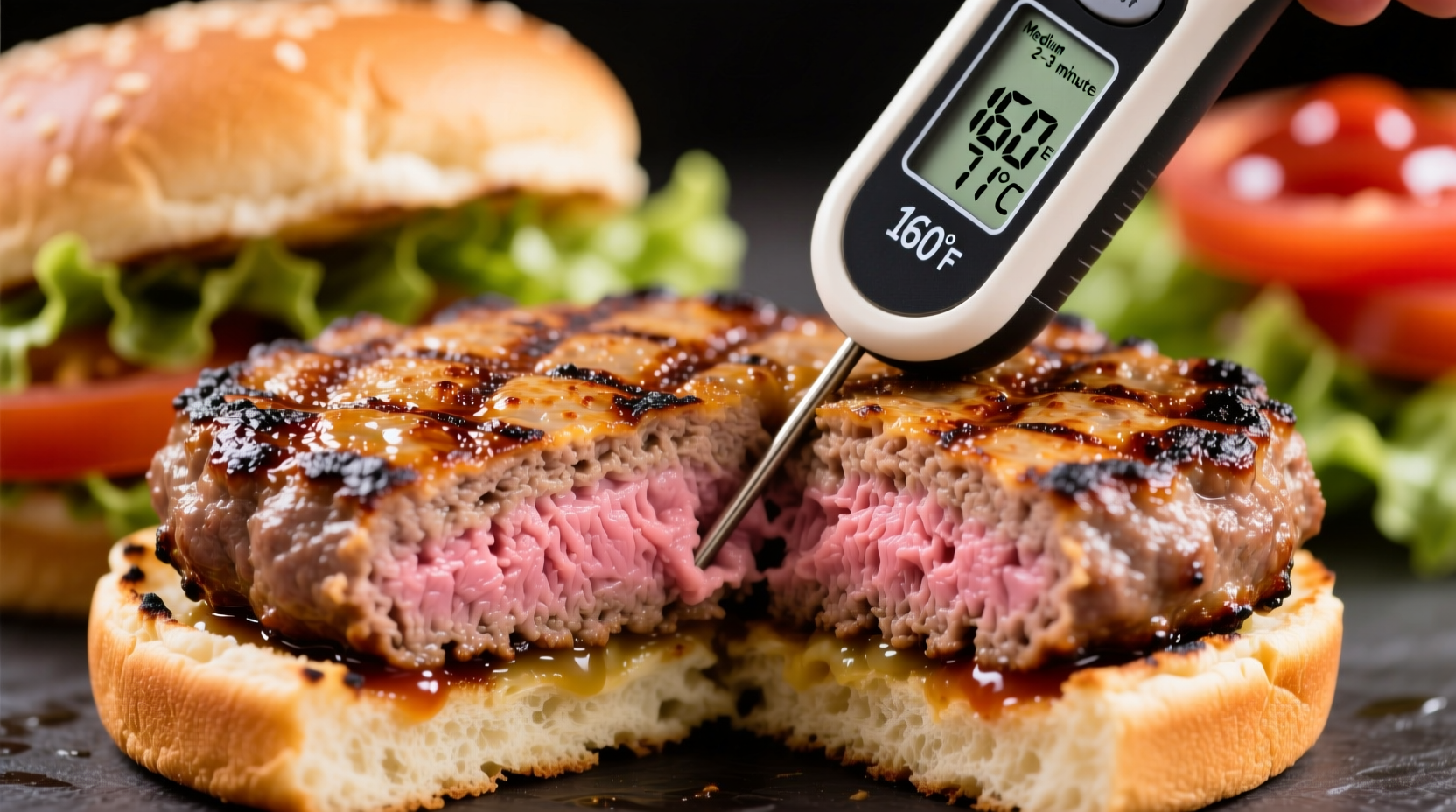Nothing ruins a backyard barbecue faster than foodborne illness. When you're grilling burgers, getting the temperature right isn't just about taste—it's a critical food safety measure that protects you and your loved ones from potentially dangerous bacteria.
Why 160°F Is Non-Negotiable for Burger Safety
Unlike whole cuts of meat where surface bacteria are the primary concern, ground beef presents unique food safety challenges. The grinding process distributes surface bacteria throughout the entire product. This means harmful pathogens like Escherichia coli (E. coli) O157:H7—which can cause severe illness—can be present throughout your burger, not just on the outside.
According to the USDA Food Safety and Inspection Service, 160°F (71°C) is the minimum internal temperature required to destroy E. coli and other dangerous bacteria in ground beef. At this temperature, pathogens are eliminated within seconds, making your burgers safe to eat.
| Burger Type | Safe Minimum Internal Temperature | Rest Time After Cooking |
|---|---|---|
| Beef, Bison, Venison Burgers | 160°F (71°C) | None required |
| Turkey or Chicken Burgers | 165°F (74°C) | 3 minutes |
| Pork Burgers | 145°F (63°C) | 3 minutes |
| Pre-cooked Ham Burgers | 140°F (60°C) | None required |
The Dangerous Myth of 'Pink Means Raw'
Many home cooks mistakenly believe that pink color indicates undercooked meat. This is particularly dangerous with burgers. Due to factors like added ingredients (onions, garlic, marinades), certain cooking methods, or even the breed of cattle, burgers can remain pink even when properly cooked to 160°F.
Conversely, burgers can appear brown before reaching a safe temperature. The USDA emphasizes that color is not a reliable indicator of doneness. Relying on visual cues alone puts you at risk of serving burgers that haven't reached the critical 160°F threshold needed to destroy harmful bacteria.

How to Measure Burger Temperature Correctly
Using a food thermometer properly is essential for accurate readings:
- Choose the right thermometer: Instant-read digital thermometers provide the most accurate and quickest readings for burgers.
- Calibrate regularly: Test your thermometer in ice water (should read 32°F/0°C) or boiling water (212°F/100°C at sea level).
- Insert correctly: Place the probe into the thickest part of the burger, avoiding contact with the grill surface or bone.
- Check multiple spots: For larger patties, check several areas as heat distribution can be uneven.
- Clean between uses: Sanitize your thermometer between measurements when checking multiple burgers.
Special Considerations for Different Burger Types
While 160°F is the standard for traditional beef burgers, different proteins require different temperatures:
- Turkey and chicken burgers must reach 165°F (74°C) due to higher salmonella risks
- Pork burgers are safe at 145°F with a 3-minute rest time
- Commercially prepared burgers may have different guidelines due to processing standards
- Restaurant cooking sometimes follows slightly different protocols under HACCP plans
For homemade burgers, always follow the 160°F guideline. The Centers for Disease Control and Prevention reports that ground beef is a common source of E. coli outbreaks, with children and elderly individuals at highest risk for complications.
Step-by-Step Guide to Perfectly Cooked, Safe Burgers
- Preheat your grill or cooking surface to medium-high heat
- Form patties evenly with a slight dimple in the center to prevent bulging
- Cook burgers for approximately 3-4 minutes per side
- Insert thermometer horizontally into the side of the patty
- Remove from heat immediately upon reaching 160°F
- Serve promptly—do not let cooked burgers sit at room temperature
Remember that residual heat will continue to cook the burger for a few minutes after removal from the heat source, potentially raising the internal temperature by 5-10 degrees.
What If You Don't Have a Thermometer?
While we strongly recommend using a thermometer, if you absolutely must estimate doneness:
- Press the center gently—the texture should be firm, not soft or squishy
- Check the juices—they should run clear, not pink or red
- Use the touch test comparing to the fleshy part of your palm (though this is highly unreliable)
However, these methods are significantly less reliable than using a thermometer. The USDA states that without a thermometer, you cannot reliably determine if your burger has reached a safe internal temperature.
Understanding the Science: Why Temperature Matters More Than Time
Food safety depends on both temperature and time. The USDA's Safe Minimum Cooking Temperatures chart shows that bacteria die at different rates depending on temperature:
- At 140°F (60°C): It takes 12 minutes to kill E. coli
- At 150°F (66°C): It takes 1 minute to kill E. coli
- At 160°F (71°C): E. coli is destroyed instantly
This explains why the 160°F standard is so critical—it provides an immediate safety margin without requiring extended cooking times that would dry out your burger.
Common Mistakes That Compromise Burger Safety
Avoid these dangerous practices that put you at risk:
- Pressing burgers with a spatula: Forces out juices and reduces internal temperature
- Cooking from frozen without adjusting time: Creates uneven cooking with cold spots
- Using the same plate for raw and cooked burgers: Causes cross-contamination
- Guessing doneness based on appearance: Leads to unsafe consumption
- Not cleaning your thermometer between uses: Spreads bacteria between patties
Following proper food handling practices alongside temperature monitoring creates multiple safety barriers against foodborne illness.
Special Considerations for At-Risk Populations
Certain groups should be especially vigilant about burger temperatures:
- Young children (under 5 years)
- Adults over 65
- Pregnant women
- Individuals with compromised immune systems
For these vulnerable populations, even a slightly undercooked burger can lead to severe complications from foodborne pathogens. When cooking for anyone in these groups, strict adherence to the 160°F standard is essential.











 浙公网安备
33010002000092号
浙公网安备
33010002000092号 浙B2-20120091-4
浙B2-20120091-4